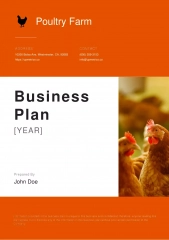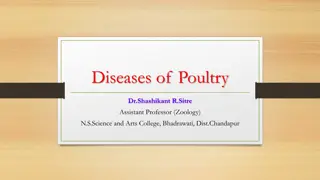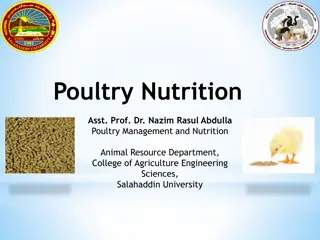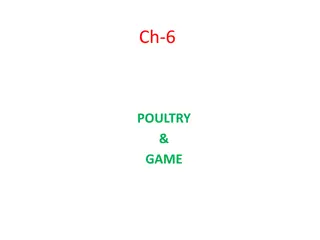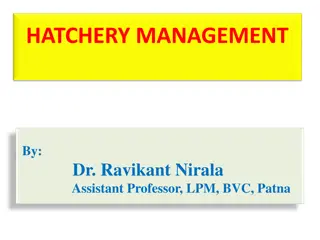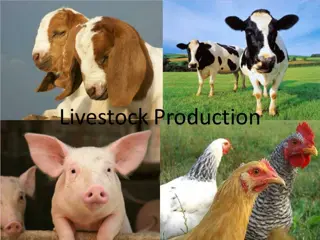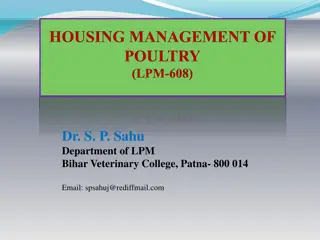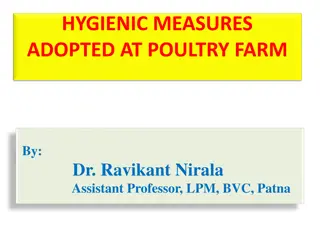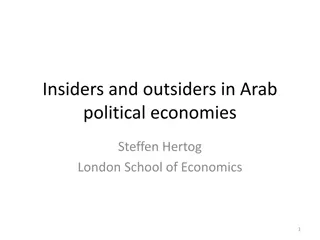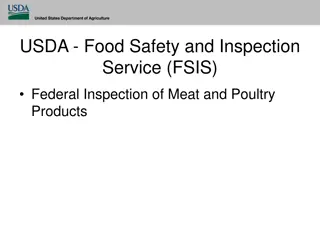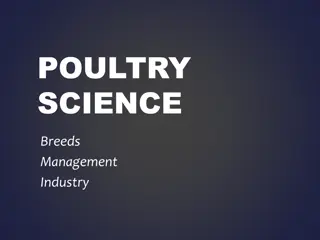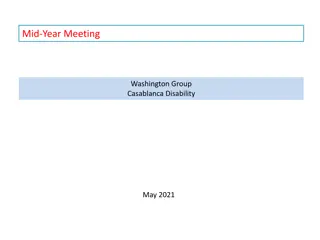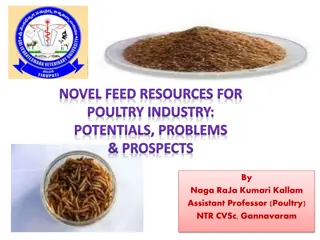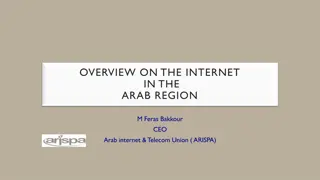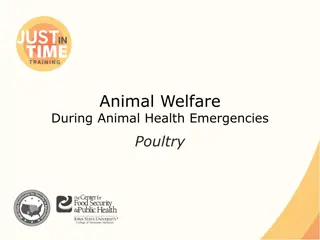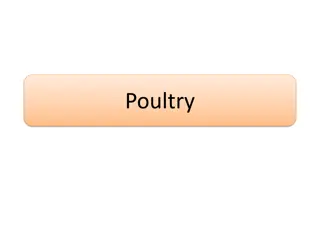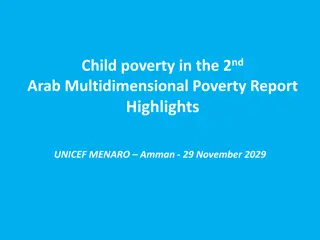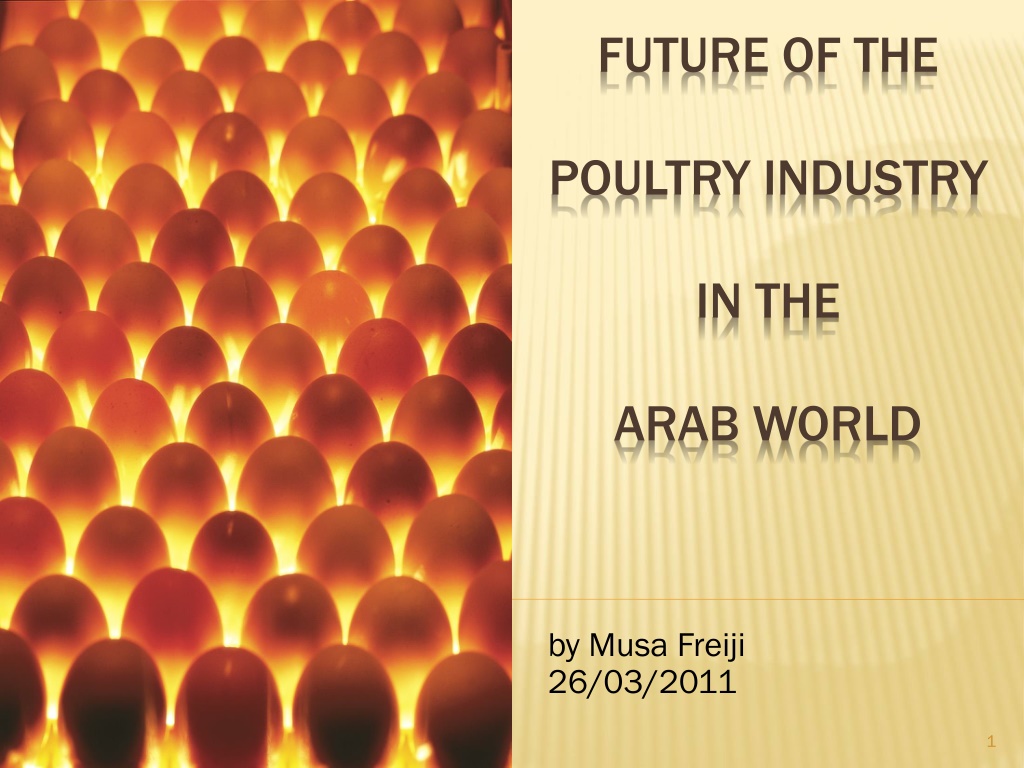
Future Prospects of Poultry Industry in the Arab World
Explore the protection and subsidy policies versus open trade policy in the poultry industry in the Arab World, along with the possibilities for its development. Insights on table egg and poultry meat production, agricultural subsidy policies, and the impact of open trade policies. Learn about the current scenario and potential future advancements in the Arab World's poultry sector.
Download Presentation

Please find below an Image/Link to download the presentation.
The content on the website is provided AS IS for your information and personal use only. It may not be sold, licensed, or shared on other websites without obtaining consent from the author. Download presentation by click this link. If you encounter any issues during the download, it is possible that the publisher has removed the file from their server.
E N D
Presentation Transcript
FUTURE OF THE POULTRY INDUSTRY IN THE ARAB WORLD by Musa Freiji 26/03/2011 1
THE POULTRY INDUSTRY IN THE ARAB WORLD Contents: Protection and subsidy policies vs. open trade policy. Future prospects of table egg and poultry meat production. Possibilities of the development of the poultry industry in the Arab World. Conclusion. Musa Freiji 2
PROTECTION & SUBSIDY POLICIES Economic policies stem out of the interests of the citizens. The private sector s ability to develop any industry. The industrialized countries adopt the subsidy policy towards agriculture. add up to $ 180 billion/yr). - Agricultural Policy in USA (various forms of subsidies 50 billion Euros/yr). - The General Agricultural Policy in Europe (in excess of Musa Freiji 3
PROTECTION & SUBSIDY POLICIES (CONT.) Justifications of the agricultural subsidy policy in the industrialized countries: - Ensure availability of safe food products at reasonable prices. - Ensure good standard of living to farmers. - Spread agriculture in all regions. - Protect the environment. - Provide healthy conditions to bird and animal populations. - Avoid migration from rural areas. - Prevent unemployment in the rural areas. Musa Freiji 4
PROTECTION & SUBSIDY POLICIES (CONT.) The USA and European subsidies represent only 0.5 % of their GNP. We cannot blame the industrialized nations for subsidizing their agriculture. Subsidy Policy has encouraged investment in agriculture and created self sufficiency and exports. Certain industrialized countries resort to protection as well: from USA. - Japan prevents imports of rice and red meat. - Very strict quality standards are imposed. - Canada imposes very high tariffs on imports of dairy, poultry and meat even The under-developed and developing countries cannot subsidize. Musa Freiji 5
PROTECTION & SUBSIDY VS. OPEN TRADE Certain Arab countries subsidize agriculture such as Saudi Arabia. Certain Arab countries still protect their agriculture such as Syria, Algiers, Lybia, Morocco, Sudan and Tunisia. The Arab countries should adopt the protectionist policy towards its poultry production. WTO approves protection but not direct subsidy. WTO members have failed so far to sign free trade agreements on agricultural products. Increase in world population will limit food exports. Most Arab countries have wrongly resorted to open trade policies of agricultural and food products. My estimates of future table egg and poultry meat production in the Arab World in light of open trade policies. Musa Freiji 6
TABLE EGG PRODUCTION (MILLION EGGS) 2008 2018 Estimate Country Production * Per Capita (Egg) Production Per Capita (Egg) Algiers 3352 92 4216 101 Comoros 14 20 17 22 Egypt 5360 67 6806 74 Lybia 1090 166 1378 183 Moritania 99 29 124 32 Morocco 4436 138 5610 152 Sudan 861 20 1093 22 Tunisia 1618 153 2038 168 Bahrain ** 49 61 54 67 Palestine 716 182 905 200 Iraq ** 1000 32 1267 35 Jordan 920 142 1161 156 Kuwait ** 400 131 505 144 Lebanon 831 195 1052 215 Oman ** 164 61 208 67 Qatar ** 76 45 98 50 Saudi Arabia 3102 114 3901 125 Syria 2753 131 3474 144 United Arab Emirates ** 313 66 395 73 Yemen 1025 46 1319 51 Arab World 28179 82 35621 90 World 1112771 161 - - Arab % of World 2.53 * Source: FAO ** Importing countries 7 Musa Freiji
TABLE EGG PRODUCTION IN CERTAIN INDUSTRIAL COUNTRIES Country Country 2008 Egg Production * 2008 Egg Production * (million eggs) (million eggs) 97067 7618 17215 10911 14545 13164 46436 Per Capita Per Capita USA Canada France UK Spain Italy Japan Average Average 312 221 262 176 315 217 365 293 293 * Source: FAO Musa Freiji 8
POULTRY MEAT PRODUCTION 2008 2018 Estimate Country 1000 MT Per Capita (Kg) 1000 MT Per Capita (Kg) Algiers 250.23 6.89 325.25 8.96 Comoros ** 0.54 0.78 0.70 1.01 Egypt ** 628.78 7.86 300.48 3.13 Lybia 120.00 18.33 156.00 23.93 Moritania 4.42 1.31 5.72 1.70 Morocco ** 430.70 13.42 200.92 6.26 Sudan 33.48 0.78 44.05 1.02 Tunisia 101.19 9.59 131.55 12.47 Bahrain ** 5.64 6.99 7.34 9.09 Palestine 46.92 11.92 61.00 15.50 Iraq ** 80.79 2.57 161.74 5.14 Jordan ** 141.42 21.85 151.59 24.04 Kuwait ** 31.38 10.29 34.54 11.32 Lebanon ** 48.38 11.37 53.23 12.51 Oman ** 5.74 2.13 6.30 2.34 Qatar ** 3.73 2.20 4.10 2.42 Saudi Arabia ** 556.47 20.51 612.21 22.56 Syria 177.76 8.47 230.99 11.01 United Arab Emirates ** 33.94 7.21 37.33 7.93 Yemen ** 134.27 5.97 147.55 6.56 Total 2921 8.53 2373 6.93 World 77619 11.24 Arab % of World 3.76 Musa Freiji * Source: FAO ** Importing countries 9
IMPORTS OF POULTRY MEAT IN MOST ARAB COUNTRIES (IN 1000 MT) Country 2008 * 2018 Estimate Algiers 0.04 0.05 Comoros 6.24 7.45 Egypt ** 296.83 700.00 Lybia 0.02 80.00 Morocco 0.31 248.00 Sudan 0.04 0.06 Tunisia 0.04 0.06 Jordan 37.51 45.00 Kuwait 191.94 230.00 Lebanon ** 9.06 50.00 Saudi Arabia 507.61 609.00 Syria 0.15 0.18 Yemen 126.10 151.00 Bahrain 23.40 28.00 Iraq 148.17 178.80 Oman 25.95 31.00 Qatar 29.27 35.00 United Arab Republic 274.45 330.00 Total 1677 2723 Musa Freiji * Source: FAO ** 2010 Imports without smuggled from Syria 10
POULTRY MEAT CONSUMPTION IN MOST ARAB COUNTRIES 2008 2018 Estimate Country 1000 MT Per Capita (Kg) 1000 MT Per Capita (Kg) Algiers 250.27 6.89 316.43 7.58 Comoros 6.78 9.81 8.58 10.79 Egypt 925.61 11.57 1170.78 12.73 Lybia 120.02 18.33 151.76 20.16 Morocco 431.01 13.43 545.16 14.77 Sudan 33.52 0.78 42.71 0.86 Tunisia 101.23 9.60 128.10 10.56 Jordan * 171.93 26.56 217.48 29.22 Kuwait * 156.45 51.28 197.94 56.41 Lebanon 105.61 24.82 133.58 27.30 Saudi Arabia 1064.08 39.21 1346.00 43.13 Syria 177.91 8.48 225.10 9.33 Yemen * 160.04 7.12 202.53 7.83 Bahrain 29.04 35.99 36.74 39.59 Iraq 228.96 7.28 289.86 8.01 Oman 31.69 11.76 40.09 12.94 Qatar 33.00 19.46 41.75 21.41 United Arab Emirates 185.03 39.31 234.06 43.24 Total / Average Tot 4212 Av 12.30 Tot 5329 Av 13.53 11 Musa Freiji * Re-exporting countries
POULTRY MEAT PRODUCTION IN CERTAIN INDUSTRIAL COUNTRIES Country Country 2008 Production 2008 Production (1000 MT) (1000 MT) Per Per Capita (Kg) Capita (Kg) USA Canada France UK Spain Italy Japan Average Average 16280 1000 1015 1293 1043 790 1365 52.34 29.07 15.42 20.84 22.60 13.04 10.72 32.21 32.21 * Source: FAO P.S. All import from Brazil except USA P.S. All import from Brazil except USA Musa Freiji 12
POSSIBILITY OF DEVELOPING THE POULTRY INDUSTRY IN THE ARAB WORLD Development of the table egg sector is feasible. - Imports of table eggs by 7 Arab Countries: Year 2000 = 383 million eggs Year 2005 = 415 million eggs Year 2010 = 481 million eggs (+961 million to Iraq) - Imports represent less than 2 % of the production of these countries, except Iraq. Musa Freiji 13
POSSIBILITY OF DEVELOPING THE POULTRY INDUSTRY IN THE ARAB WORLD (CONT.) Development of the poultry meat sector is problematic. - Cost of production is double that of Brazil or USA or Ukraine. - Imports of poultry meat by the largest 10 Arab Countries: Year 2000 = 465,000 MT Year 2005 = 770,000 MT Year 2010 = 1,638,000 MT 5 yrs. - Increase in imports were 66 % in the first 5 yrs, and 213 % in the second %. - Import duties on poultry meat in those countries ranged from 0 % to 30 Musa Freiji 14
POSSIBILITY OF DEVELOPING THE POULTRY INDUSTRY IN THE ARAB WORLD (CONT.) Conditions to develop the production of the poultry meat sector: Increase import duties. Reduce cost of production by 70 %. 1. 2. Reduction of cost of production: - It is possible to reduce present cost of production by about 30 % via: Reduction of mortality to 5 % or lower. Reduction of Feed Conversion to 1.7 or lower. Increase of day-old chicks per hen housed to 135 or better. Musa Freiji 15
POSSIBILITY OF DEVELOPING THE POULTRY INDUSTRY IN THE ARAB WORLD (CONT.) Local production of feed ingredients may reduce the cost by a further 30 %. - Ethanol production from corn in USA resulted in increase in cost of corn and oil seeds. - USA is adamant about doubling its ethanol production by year 2015 compared to year 2009. - This policy will result in escalating corn and soya prices with time. Musa Freiji 16
POSSIBILITY OF DEVELOPING THE POULTRY INDUSTRY IN THE ARAB WORLD (CONT.) Therefore plantation of corn & oil seeds is becoming more feasible. - Sudan is a long time producer of sorghum and sesame. - Only 60 million hectares out of 135 million arable land are presently planted. - Sudan enjoys two Nile rivers and excellent fertile land and underground water. Musa Freiji 17
THE POULTRY INDUSTRY IN THE ARAB WORLD Conclusion Table egg production will continue to satisfy local demands. Poultry meat production will drop to levels equal to demands of fresh poultry meat. Development of poultry meat production requires: - Protection of the local sectors. - Reduction of cost of production via: Improved productivity. Plantation of feed ingredients. Musa Freiji 18
THANK YOU Musa Freiji 19

